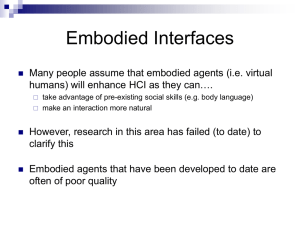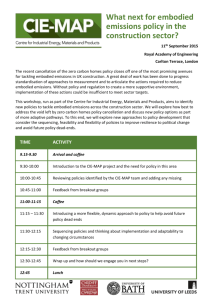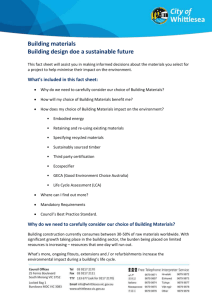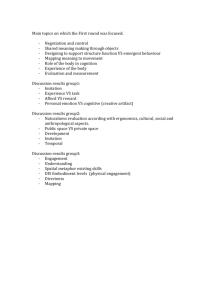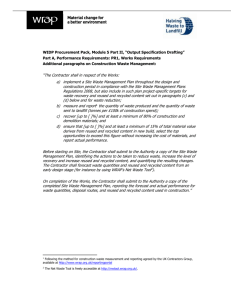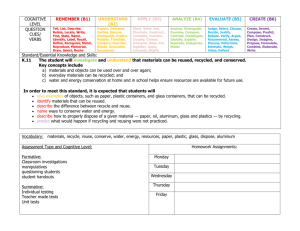The environmental impact of building materials Materials selection is
advertisement
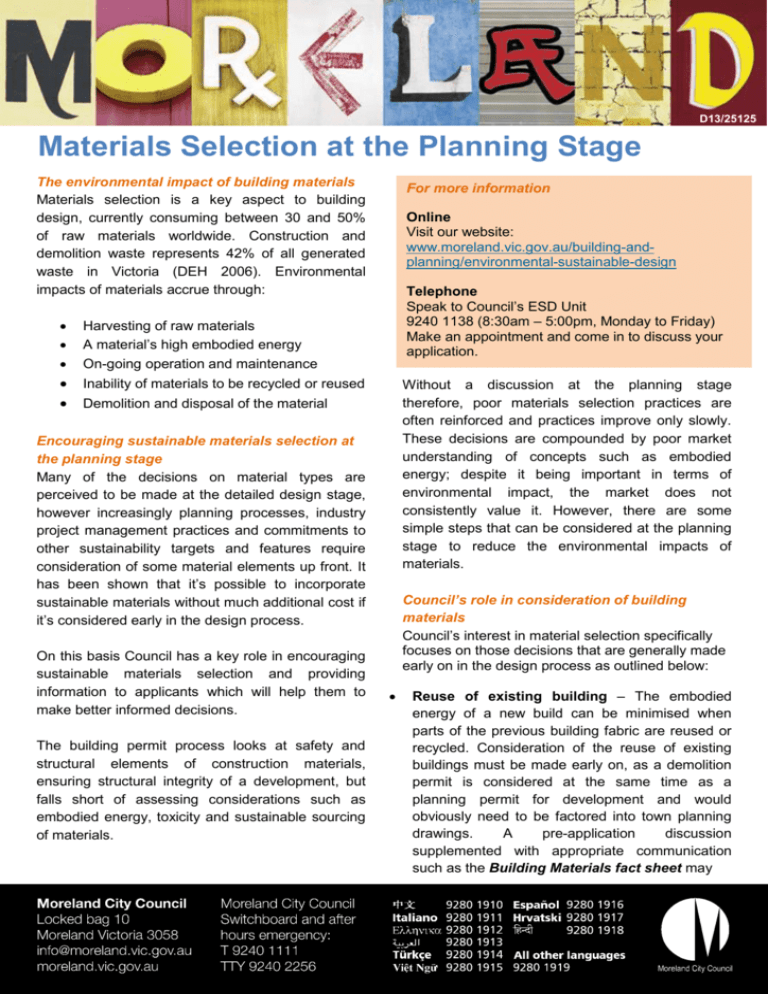
D13/25125 Materials Selection at the Planning Stage The environmental impact of building materials Materials selection is a key aspect to building design, currently consuming between 30 and 50% of raw materials worldwide. Construction and demolition waste represents 42% of all generated waste in Victoria (DEH 2006). Environmental impacts of materials accrue through: Harvesting of raw materials A material’s high embodied energy On-going operation and maintenance Inability of materials to be recycled or reused For more information Online Visit our website: www.moreland.vic.gov.au/building-andplanning/environmental-sustainable-design Telephone Speak to Council’s ESD Unit 9240 1138 (8:30am – 5:00pm, Monday to Friday) Make an appointment and come in to discuss your application. Without a discussion at the planning stage therefore, poor materials selection practices are often reinforced and practices improve only slowly. These decisions are compounded by poor market understanding of concepts such as embodied energy; despite it being important in terms of environmental impact, the market does not consistently value it. However, there are some simple steps that can be considered at the planning stage to reduce the environmental impacts of materials. Demolition and disposal of the material Encouraging sustainable materials selection at the planning stage Many of the decisions on material types are perceived to be made at the detailed design stage, however increasingly planning processes, industry project management practices and commitments to other sustainability targets and features require consideration of some material elements up front. It has been shown that it’s possible to incorporate sustainable materials without much additional cost if it’s considered early in the design process. On this basis Council has a key role in encouraging sustainable materials selection and providing information to applicants which will help them to make better informed decisions. The building permit process looks at safety and structural elements of construction materials, ensuring structural integrity of a development, but falls short of assessing considerations such as embodied energy, toxicity and sustainable sourcing of materials. Council’s role in consideration of building materials Council’s interest in material selection specifically focuses on those decisions that are generally made early on in the design process as outlined below: Reuse of existing building – The embodied energy of a new build can be minimised when parts of the previous building fabric are reused or recycled. Consideration of the reuse of existing buildings must be made early on, as a demolition permit is considered at the same time as a planning permit for development and would obviously need to be factored into town planning drawings. A pre-application discussion supplemented with appropriate communication such as the Building Materials fact sheet may D13/25125 prompt an applicant to consider an element of building re-use or on-site recycling of materials. Efficient Design – Early design stage provides an opportunity to consider how the material use can be reduced through efficient design. Material use could be reduced by designing for: smaller unit sizes; less bathrooms; residences that do not require heating and cooling and ventilation systems and ductwork; designs that do not require finishes, e.g. exposed concrete, materials that form a dual function, e.g. roof top garden substrate or photovoltaic shingles serving as cladding. Construction method – The concept design stage represents an opportunity to consider modular construction or other alternative construction methods, which can reduce the embodied energy of a building. This could extend to pre-fabricated kitchens and bathrooms to entire pre-fabricated buildings. The pre-feasibility stage of a project will usually determine what type of construction method will be used for the project and therefore providing information and encouragement for developers to investigate more sustainable construction methods at the pre-application stage may help encourage deployment of these alternatives to traditional construction. Construction type – Some components of construction type are decided early in the design process as this helps with project planning and determining feasibility. This extends to commitments to such decisions as the use of a high percentage of recycled material in concrete (as recycled material such as flyash can affect curing times) or minimising waste and materials use by limiting the fitout of commercial tenancies to common areas only. External materials selection – In order to properly assess the merits of a development in terms of neighbourhood character and urban design issues, the external materials of the development are locked in through the approval of a materials palette and elevations as part of a planning submission. This provides an opportunity for Council to consider not only urban design considerations, but also recommend that applicants consider that more sustainable materials may be appropriate for the building exterior, for example FSC certified products in place of cement sheeting or highly refined metals. Nexus with other assessment criteria areas – Materials selection greatly impacts other assessment areas within Council’s Environmentally Efficient Design policy. Additionally, some commitments in other assessment areas rely on making quite specific commitments for materials selection. This may create the opportunity to discuss improvements and encourage more sustainable selection of some building elements. For example: - - - An ability to make good on a commitment to high thermal efficiency may rely on specific materials being used in the exterior or interior building fabric A commitment to good daylight to habitable areas may depend on light from a light court using reflective paints to refract light in lower levels Material selection may impact greatly on the ability to reach construction waste targets Materials decisions are best made at the earliest stages in the design process. For more information refer to Council’s website and the Building Materials fact sheet.
